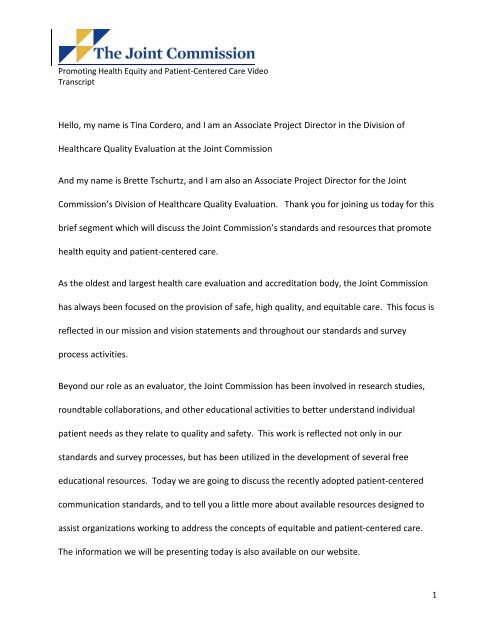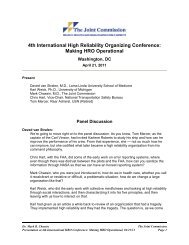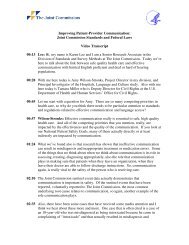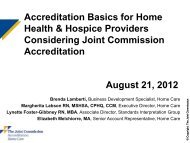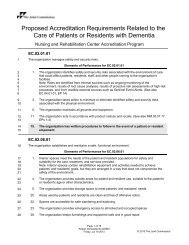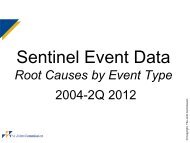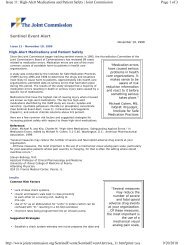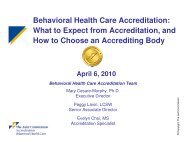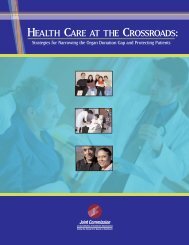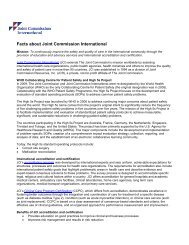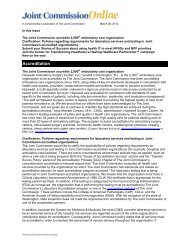View Video Transcript - Joint Commission
View Video Transcript - Joint Commission
View Video Transcript - Joint Commission
You also want an ePaper? Increase the reach of your titles
YUMPU automatically turns print PDFs into web optimized ePapers that Google loves.
Promoting Health Equity and Patient-Centered Care <strong>Video</strong><br />
<strong>Transcript</strong><br />
Hello, my name is Tina Cordero, and I am an Associate Project Director in the Division of<br />
Healthcare Quality Evaluation at the <strong>Joint</strong> <strong>Commission</strong><br />
And my name is Brette Tschurtz, and I am also an Associate Project Director for the <strong>Joint</strong><br />
<strong>Commission</strong>’s Division of Healthcare Quality Evaluation. Thank you for joining us today for this<br />
brief segment which will discuss the <strong>Joint</strong> <strong>Commission</strong>’s standards and resources that promote<br />
health equity and patient-centered care.<br />
As the oldest and largest health care evaluation and accreditation body, the <strong>Joint</strong> <strong>Commission</strong><br />
has always been focused on the provision of safe, high quality, and equitable care. This focus is<br />
reflected in our mission and vision statements and throughout our standards and survey<br />
process activities.<br />
Beyond our role as an evaluator, the <strong>Joint</strong> <strong>Commission</strong> has been involved in research studies,<br />
roundtable collaborations, and other educational activities to better understand individual<br />
patient needs as they relate to quality and safety. This work is reflected not only in our<br />
standards and survey processes, but has been utilized in the development of several free<br />
educational resources. Today we are going to discuss the recently adopted patient-centered<br />
communication standards, and to tell you a little more about available resources designed to<br />
assist organizations working to address the concepts of equitable and patient-centered care.<br />
The information we will be presenting today is also available on our website.<br />
1
Promoting Health Equity and Patient-Centered Care <strong>Video</strong><br />
<strong>Transcript</strong><br />
Each patient is unique. In addition to their clinical concerns, patients’ bring specific<br />
characteristics and non-clinical needs to the health care encounter that can affect the way they<br />
view, receive, and participate in their health care. A growing body of research has<br />
demonstrated that a variety of patient populations experience less safe or lower quality care or<br />
poorer health outcomes associated with their race, ethnicity, language, disability, or sexual<br />
orientation. These studies document that among other factors, disparities in health care can be<br />
attributed to cultural or language differences, which can impair communication with caregivers,<br />
limit access to health care, and contribute to fears of discrimination or even perceived fears of<br />
discrimination. To improve the overall safety and quality of care provided in hospitals’<br />
nationwide, health care organizations should aspire to meet the unique needs of each of their<br />
patients.<br />
In January of 2010, The <strong>Joint</strong> <strong>Commission</strong> released a set of new and revised standards for<br />
patient-centered communication as part of an initiative to advance the issues of effective<br />
communication, cultural competence, and patient- and family-centered care. These standards<br />
are designed to improve the safety and quality of care for all patients and to inspire hospitals to<br />
adopt practices promoting better communication and patient engagement.<br />
In addition to our standards and survey process activities, through funding from the<br />
Commonwealth fund and the California Endowment, The <strong>Joint</strong> <strong>Commission</strong> has developed two<br />
educational monographs designed to inspire hospitals to go above and beyond what is required<br />
in the standards and adopt practices promoting better communication and more patient- and<br />
2
Promoting Health Equity and Patient-Centered Care <strong>Video</strong><br />
<strong>Transcript</strong><br />
family-centered care. Research has demonstrated that incorporating the concepts of cultural<br />
competence and patient- and family-centeredness into the care process can increase patient<br />
satisfaction and adherence with treatment. Hospitals that do not adequately address cultural,<br />
communication, mobility, and other patient needs will continue to put themselves and their<br />
patients at risk for negative consequences. We will discuss these resources in more depth<br />
after a brief review of the new standards.<br />
As a whole, the patient-centered communication address several important issues such as<br />
qualifications for language interpreters and translators, the importance of identifying and<br />
addressing patient communication needs, and the collection of patient-level data around<br />
preferred language, race, and ethnicity. The standards also address patient- and familycentered<br />
care issues, including having access to a support person and receiving care free from<br />
discrimination.<br />
The first standard we’ll discuss is in our Human Resources chapterWe’ve added clarification<br />
specific to the qualifications for interpreters and translators, such as language proficiency<br />
assessment, education, training, and experience, and hospitals have flexibility to determine<br />
what combination of qualifications works best for their patient populations.<br />
We’ve also added a standard in our provision of care, treatment, and services chapterfocused<br />
on effective patient provider communication. As we mentioned earlier, this concept is not new<br />
to our standards, but we’ve highlighted it in our provision of care chapter to stress the<br />
importance of two-way communication between patients and providers. The expectation here<br />
3
Promoting Health Equity and Patient-Centered Care <strong>Video</strong><br />
<strong>Transcript</strong><br />
is to identify and address the patient’s oral and written communication needs, which includes<br />
the patients preferred language for discussion health care, and we’ve provided organizations<br />
with some examples of potential patient communication needs.<br />
In keeping with the theme of effective communication, we’ve also added some additional<br />
guidance regarding the provision of interpreting and translation services. Again, there is some<br />
flexibility here for hospitals to determine which modes of services to provide, such as in-person,<br />
telephone, or video options.<br />
The next two standards highlight the importance of collecting patient-level data. The<br />
collection of patient-level demographic data on preferred language, race, and ethnicity<br />
provides hospitals with information on the potential needs of each patient, as well as an<br />
opportunity to monitor and analyze health disparities at the population level. Our standards<br />
do not specify how to collect or categorize these data elements, but we do provide several<br />
examples in our educational monographs.<br />
Finally, we’ve added two new elements of performance in our Patient Rights standards. These<br />
new requirements are focused on access to a support individual and the provision of equitable<br />
care. We’ve added a requirement that requires that hospitals to allow patients to have a<br />
support person with them during their stay. The important thing to note is that this person is<br />
one of the patients’ choice. This person could be a family member, friend, or any individual the<br />
patient chooses to be with them, and this raises awareness of the need for policies that are<br />
inclusive of those individuals whom the patient identifies as important. This issue is of course<br />
4
Promoting Health Equity and Patient-Centered Care <strong>Video</strong><br />
<strong>Transcript</strong><br />
important to all patients, but particularly those in the Lesbian, Gay, Bisexual, and Transgender<br />
community, who have unfortunately experienced limited access to loved ones in the health<br />
care settings. Element of Performance 29 says that patients receive care free from<br />
discrimination based on several personal characteristics.<br />
Although several laws and<br />
regulations include anti-discrimination protections, state laws vary. Element of Performance 29<br />
underscores the importance of providing equitable care to ALL patients, regardless of individual<br />
differences.<br />
Now that we’ve highlighted the new requirements, let’s talk about the resources we’ve<br />
developed to help hospitals implement these standards, and drive the issues of communication,<br />
cultural competence, and patient- and family-centered care forward. The Roadmap for<br />
Hospitals was released in August of 2010, and is designed to inspire organizations to integrate<br />
these concepts into their systems of care delivery. Many of the recommendations go above<br />
and beyond the expectations in the standards themselves, but the goal of the Roadmap is to<br />
encourage organizations to truly advance these issues in their organizations. In addition, it<br />
provides many examples, strategies, resources, and definitions that can assist hospitals in these<br />
efforts.<br />
In addition to the Roadmap, we’ve released a field guide in November 2011 that focuses<br />
specifically on the needs of the lesbian, gay, bisexual, and transgender (or LGBT) community.<br />
Like many other populations identified as at-risk, those in the LGBT community have<br />
experienced health disparities and significant barriers to equitable care, however only recently<br />
5
Promoting Health Equity and Patient-Centered Care <strong>Video</strong><br />
<strong>Transcript</strong><br />
has awareness of these barriers been brought to the national stage. While the Roadmap<br />
addresses several salient issues that arise in meeting the health care needs of this community,<br />
the Field Guide provides additional and more specific information to assist organizations in<br />
creating a safer and more inclusive environment for their LGBT patients and families that will<br />
contribute to higher quality care. Just like the Roadmap, the Field Guide goes above and<br />
beyond what is required in the standards and highlight strategies, practice examples, and<br />
testimonials to assist organizations in their efforts to better meet the needs of the LGBT<br />
community.<br />
The rationale behind the development of the standards, the Roadmap for Hospitals, the Field<br />
Guide, and many other helpful resources from the Division of Healthcare Quality Evaluation are<br />
available for free down load on our project webpage. For further guidance on the<br />
interpretation of the standards, please contact our Standards Interpretation Group.<br />
We hope we’ve provided you with some valuable information on the <strong>Joint</strong> <strong>Commission</strong>’s<br />
standards and resources that promote health equity and patient-centered care. Please feel<br />
free to contact us with any additional questions. Thank you for joining us today.<br />
6


